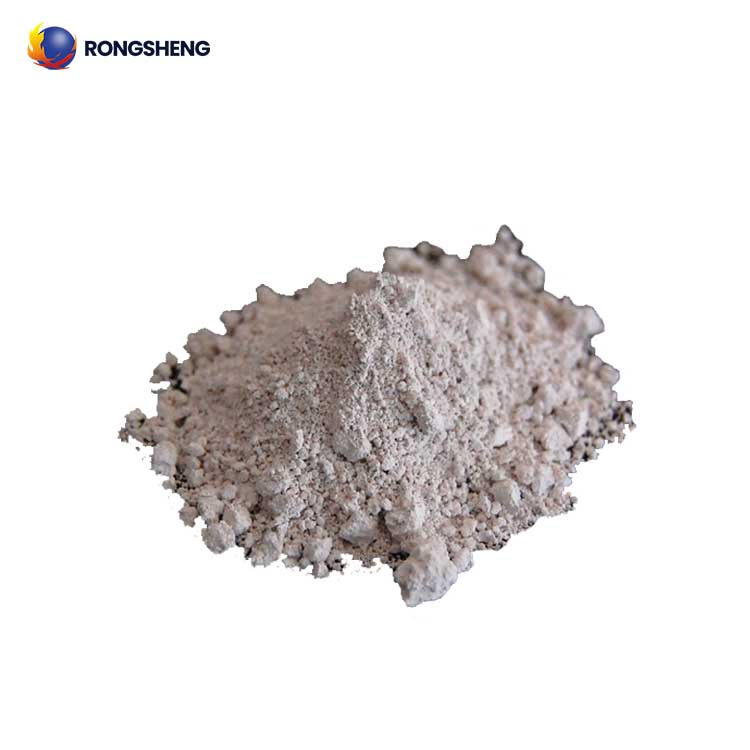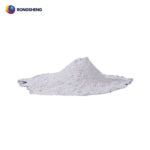
Zirconium Silicate
- High refractive index (1.93~2.01).
- Good chemical stability, high melting point, and high-temperature resistance.
- Fine particle size, and good dispersibility.
- Strong covering power, good opacity, and good fluidity.
- Strong wear resistance and whitening effects.
We are Here to Help!
Email: sales@hy-refractory.com
WhatsApp: +86 185 3831 2977
What is Zirconium Silicate? Zirconium silicate is a non-toxic, odorless white or off-white powder. Zirconium silicate is processed from natural zircon sand by ultra-fine grinding, iron removal, titanium removal, and other processes. It is characterized by a high refractive index (1.93~2.01), good chemical stability, and high-temperature resistance.
| Name | Zirconium Silicate | Chemical Formula | ZrSiO₄ |
| Solubility | Insoluble in water | Color | White or off-white |
| Category | Inorganic – silicate – zirconium salt | Theory Composition | ZrO2(67.2%); SiO2( 32.8%) |
| Other Names | Zirconium silicate, 99%; zirconium(4+) orthosilicate; zirconium(2+) oxosilanediolate; dioxido-oxo-silane; zirconium(+4) cation | ||
Zirconium Silicate Properties
Zirconium silicate is a product obtained by mechanically grinding zircon sand to a particle size of <10um, and its color is generally white or light gray. Zirconium silicate is one of the essential raw materials in the ceramic industry and is widely used in glazes and blanks. Its main function is to opacify and whiten.
The chemical stability of zirconium silicate is manifested in high melting points and high-temperature resistance. During the firing process, it is not affected by the firing atmosphere of the ceramics, and can significantly improve the bonding properties of the ceramics with the glaze. As an opacifier, Rongsheng‘s new zirconium silicate has the characteristics of fine particle size, good dispersibility, strong covering power, good opacity, and good fluidity, and has strong wear resistance and whitening effect.
Zirconium Silicate Physical Properties
| Specific Gravity | 4.69 |
| Melting Point | 2500°C |
| Refractive Index | 1.97 |
| Mohs Hardness | 7.5 |
| Thermal Expansion Coefficient | 4.2*10-6 |
| Appearance | White or off-white powder |
Zirconium Silicate Chemical Properties
| Item | RS65 | RS64.5 | RS63.5 |
| ZrO2+HfO2 | 65.0 min | 64.5 min | 63.5 min |
| Fe2O3 | 0. 06 max | 0. 08 max | 0. 12 max |
| TiO2 | 0.10 max | 0.12 max | 0.18 max |
RS Zirconium Silicates Product Specifications
| Type | Average mesh | Application |
| RS-1.0 | D50≤1.0um | High-grade sanitary porcelain High-grade daily-use porcelain High-grade crystal brick |
| RS-1.2 | D50≤1.2um | |
| RS-1.5 | D50≤1.5um | Middle and low class sanitation porcelain,external and internal brick, archaized brick, engobe, body, etc. |
| RS-2.0 | D50≤2.0um |
What is Zirconium Silicates Used For?
zirconium silicate uses:
- As an opacifier, zirconium silicate is widely used in various types of ceramic glazes. For example, architectural ceramics, sanitary ceramics, household ceramics, etc.
- It is also widely used in precision casting, color picture tubes, float glass, enamel glaze, and other industries.
- In the plastics industry. For epoxy formulations, sealing resins, fillers for silicones, vinyls, and resins to increase heat resistance and improve resistance insulation values, for fillers that require inert, fine, white, and chemical resistance.
- In addition, due to the high melting point of zirconium silicate, it is also widely used in refractory materials, zirconium ramming materials for glass furnaces, castables, and spray coatings.
Zirconium Silicate Powder Processing Technology
The main raw material for zirconium silicate is zircon sand. The main component of zircon sand is zirconium silicate, the molecular formula is ZrSiO4. In zircon, there is generally 0.5% to 2% hafnium, and the correct chemical formula should be written as (Zr, Hf) SiO4. Theoretically, the chemical composition of zirconium silicate is: w(ZrO2)=67.2%, w(SiO2)=32.8%. In fact, it often contains Fe2O3, TiO2, Al2O3, and other components.
The preparation of zirconium silicate ultrafine powder adopts the mechanical pulverization method. The mechanical pulverization method has the advantages of low production cost, high output, simple process, and easy realization of large-scale production. Mechanical pulverization methods include dry process and wet process. Therefore, the processing technology of zirconium silicate ultrafine powder is also divided into dry process and wet process.
High-performance zirconium silicate (ie, zirconium silicate ultrafine powder), when it has two conditions of whitening and stability. The properties of zirconium silicate powder, particle morphology, particle size range, dispersion performance in media, and opacity segregation after application of brick or glaze are better than conventional zirconium silicate.
What is the Role of Zirconium Silicates in Glaze?
- Whitening: improve product whiteness;
- Opacity: cover the color and sundries of the bottom green body;
- Toughening: Increase the toughness of the glaze to prevent cracks;
- Wear resistance: Increase the wear resistance of glazed floor tiles.
The role of zirconium silicate in the glaze is mainly to increase the whiteness, in addition to increasing the firing temperature and improving the elasticity of the glaze. A certain amount of zirconium silicate is added to the polished ultra-white floor tiles we use every day. There is also a certain amount of zirconium silicate on the glaze of the tiles that are laid in our daily bathrooms and other places. Its function is also mainly to increase the whiteness, and also to increase the elasticity of the glaze, that is, to solve the phenomenon of cracking of the tiles.
Why Can Zirconium Silicate be Used as a Ceramic Glaze?
Zirconium silicate has an opacifying effect in the glaze, mainly by using the difference in its refractive index with that of the base glaze. When the light enters the glaze layer, refraction and reflection occur at the interface between the zirconium silicate particles and the glass phase, which makes the glaze layer opaque and plays an opacifying effect. When its particle size is around the visible wavelength range, ie 380-780 nm, its opacifying effect is the best.
Part of the zirconium silicate particles in the glaze layer are the zirconium silicate particles remaining in the glaze without melting, and the other part is the zirconium silicate crystallites precipitated during the cooling process after melting. The opacifying effect in the raw glaze is mainly caused by the fine particles of zirconium silicate remaining in the glaze. When the zirconium silicate particles in the glaze layer are mainly residual phases, the finer the particle size, the better and more uniform the dispersion in the glaze layer, and the better the opacity of the glaze.
The important conditions for obtaining the best opacity effect are the fineness of zirconium silicate, the amount added, the reasonable composition of the base glaze, the thickness of the glaze layer and the best firing temperature. The fineness of zirconium silicate plays a decisive role when the addition amount, the reasonable composition of the base glaze, the thickness of the glaze layer and the optimal firing temperature remain unchanged.
When the zirconium silicate contains metal impurities, the impurities in the zirconium silicate are not completely separated from it, but are associated together, which will inevitably affect its refractive index. Thereby, the difference between the refractive index of zirconium silicate and the base glaze is reduced, and the opacity effect is reduced. Therefore, in the case of the same particle size, the higher the purity of zirconium silicate, the better the opacification effect.
Therefore, the fineness and purity in the ultrafine processing of zirconium silicate are the key factors that determine the quality of its products. Combining the theoretical calculation and the actual situation of powder production, the d50 value of high-performance zirconium silicate is controlled below 1.4um and the d90 value is controlled below 4.0um, which will produce the best opacity and whitening effect. In the whitening effect of zirconium silicate, the concentrated particle size range is very important, and it is required to achieve as narrow a particle distribution as possible during the grinding process of zirconium silicate.
The Dosage of Zirconium Silicates in Traditional Ceramic Industry
Zirconium silicate has a better effect when adding raw material to medium and high-temperature glaze. A certain amount of zirconium silicate is generally added to the high-gloss and matt glazes of sanitary ware and glazed porcelain tiles. As the above two categories of products have good development prospects in the Chinese market, the consumption of zirconium silicate will increase.
The application ratio of zirconium silicate in the traditional ceramic industry. Daily ceramics and sanitary ware are mainly used for the high-temperature opaque glaze, and their content is 8-12% and 8-14% respectively. Glazed interior wall tiles are used for cosmetic soil and zirconium white frit, the content of which is 4-10% and 10-12% respectively. The early porcelain polished tiles were used for ultra-white tiles, and their content was 3-5%, more than 3-5%, and the internal irradiation and external irradiation increased significantly. Therefore, many companies reduce the amount of zirconium silicate in polished tiles, generally adding 1-2%, and glazed products will also add 1% zirconium silicate or zircon powder to increase stability, but this is not the main application. The application of zirconium silicate in pigment-related fields is more than 50%.
In some areas, the whiteness of polished tiles was once pursued, so more zirconium silicate was used in the formula of porcelain blanks. Some enterprises use up to 3-5%, which greatly increases the amount of zirconium silicate. At the same time, it is found that a large amount of addition makes the radioactivity of polished tiles exceed the standard. Therefore, at present, the general dosage of enterprises is reduced to 1-2%, and the amount added in some ultra-white line points can reach 3-5%.
Zirconium Silicate Manufacturers
As one of the zirconium silicate manufacturers, Rongsheng provides high-quality zirconium silicate for ceramic glazes, to get the latest zirconium silicate price, please contact us or send us an email.





